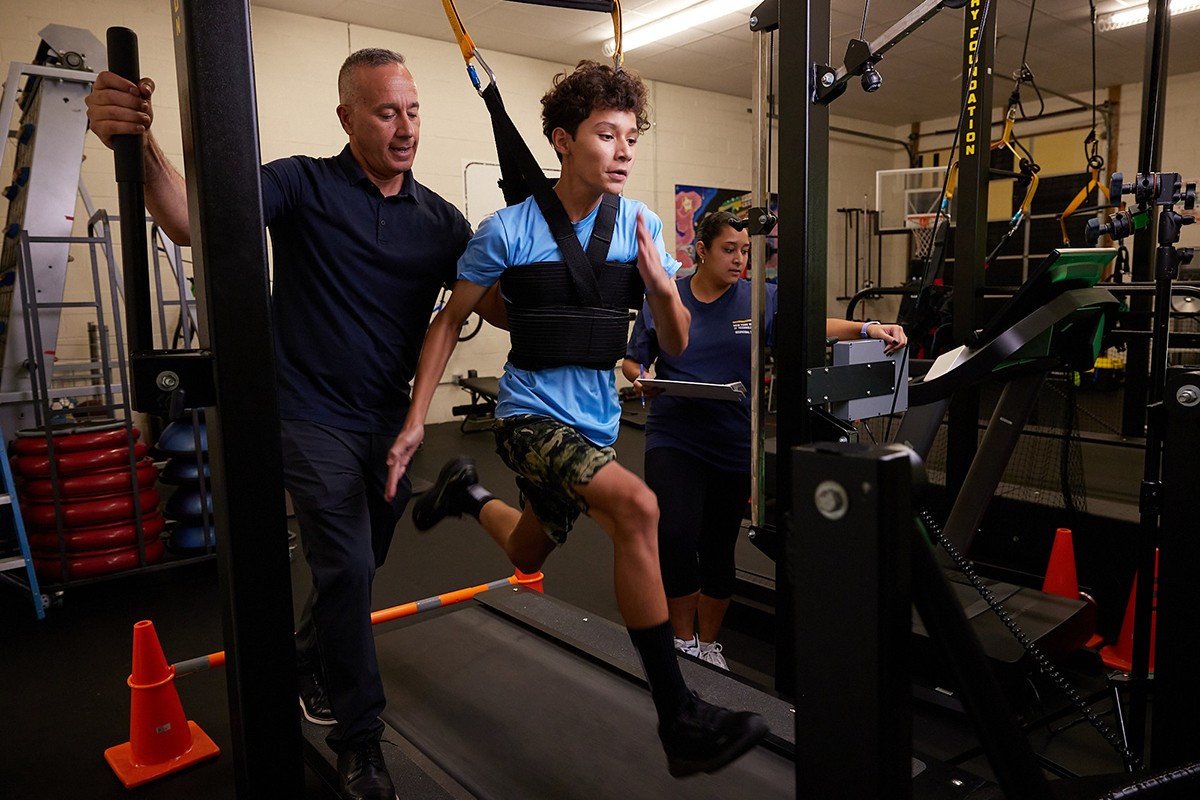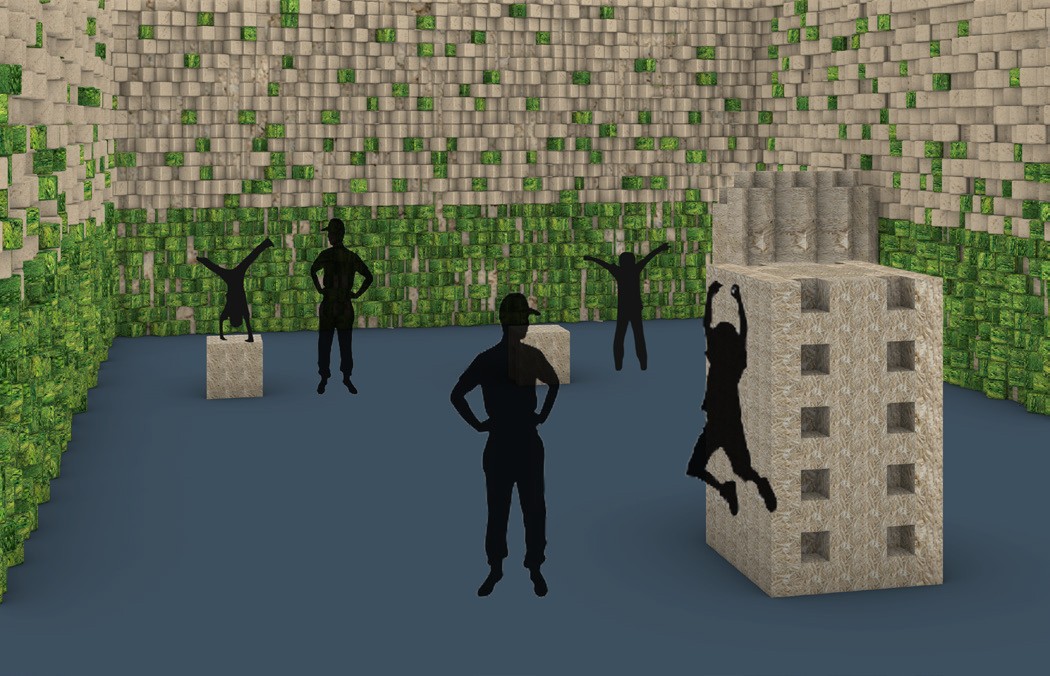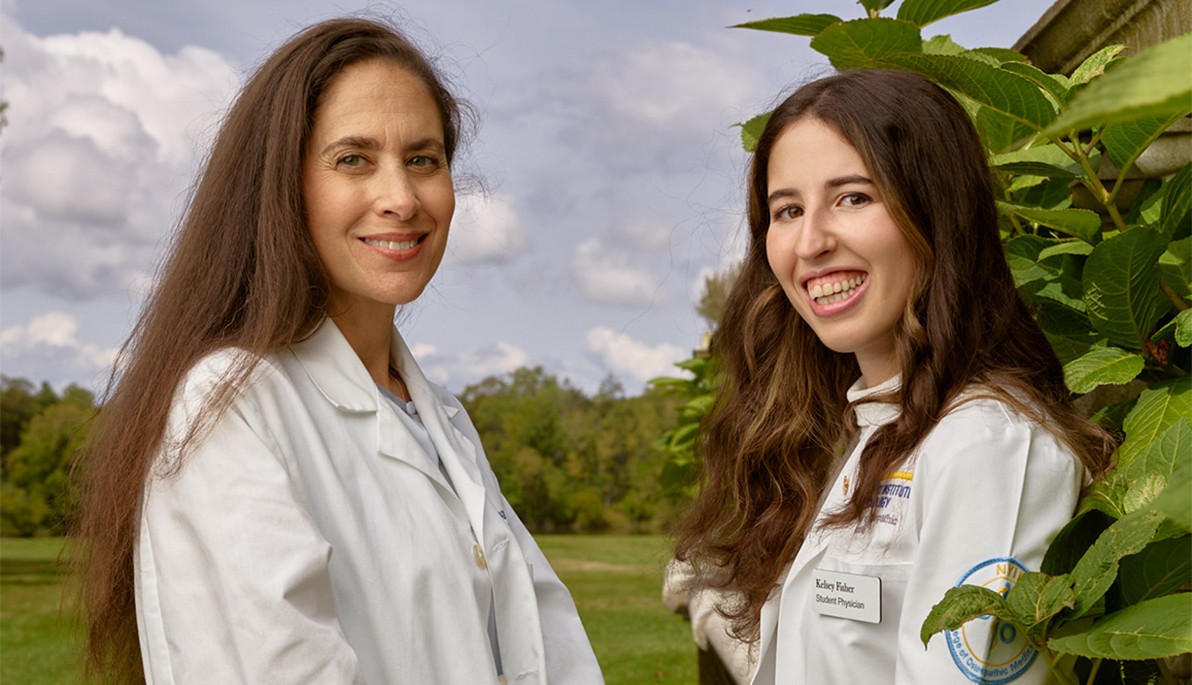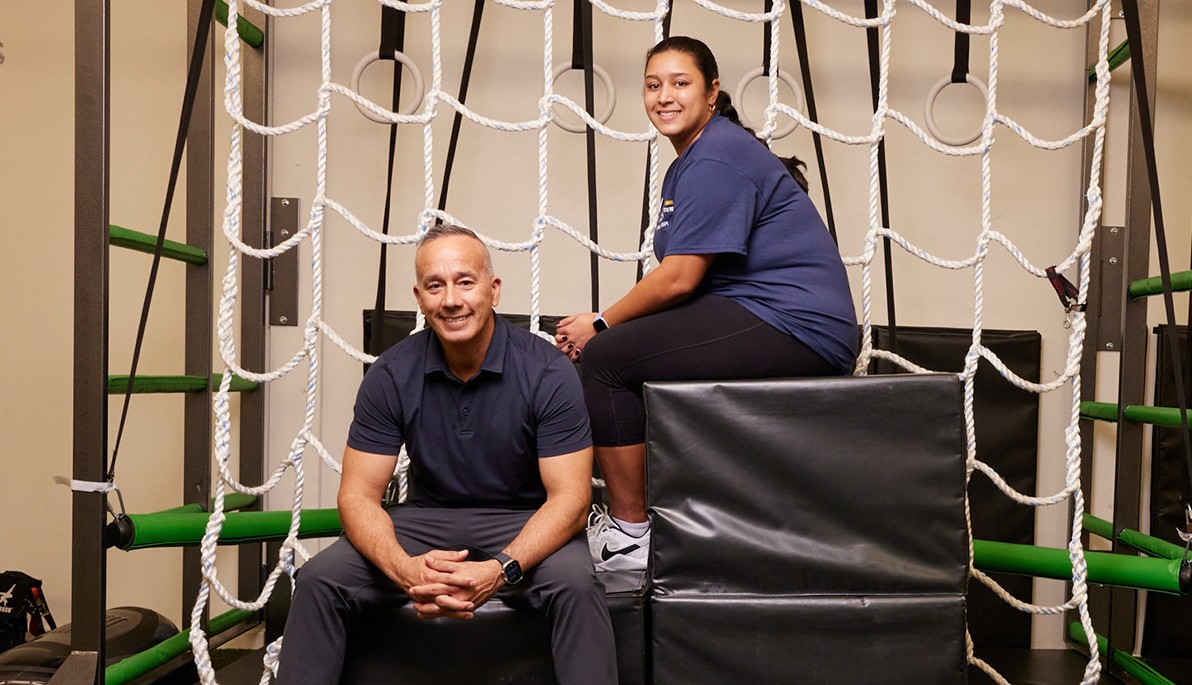News
Putting Knowledge and Skill Into Action
December 6, 2023
Pictured above: Alexander Lopez, left, and Jacinda Ayres at Inclusive Sports and Fitness
New York Institute of Technology reaches far beyond the classroom to positively impact communities. The vast interdisciplinary collaborations supported by New York Tech enable faculty and students to evolve as architects, engineers, therapists, and doctors to advance positive outcomes and grow beyond the traditional career path, turning ideas into innovative solutions to address challenges within the populations they serve.
In 2020, the World Health Organization stated that neurological disorders are the number one cause of disability globally. Leveraging the depth of expertise and breadth of individual passions, New York Tech faculty and students are making strides in advancing the understanding of autism spectrum disorder and Parkinson’s disease.
Unparalleled Opportunities

Army veteran, attorney, licensed occupational therapist, and Associate Professor of Occupational Therapy Alexander Lopez, J.D., OT/L, FAOTA, is all about promoting health, wellness, and justice for all communities. He envisions a world where every person is encouraged to develop and use their unique talents for the greater good.
Lopez was attracted to New York Tech because of the university’s commitment to collaboration, multidisciplinary research, and deep student involvement. “The collaborations with other professors and students enable us to advance technology and discover innovative solutions beyond what any individual could contribute, leading to lasting change within communities,” he says.
One such collaboration that supports the infusion of new ideas from students exists with Inclusive Sports and Fitness (ISF). ISF is a nonprofit gym in Holbrook, N.Y., founded by Lopez that helps children with developmental and intellectual disorders improve their social, emotional, cognitive, and sensorimotor abilities through occupational therapies and targeted exercise interventions.
“Movement drives all performance,” he says. “Movement is engagement; it forces us to organize our thoughts, senses, and motor functions and is crucial in helping us navigate the world.”
Movement Is Key to Performance

Through a New York Tech Institutional Support for Research and Creativity grant, a clinical trial this fall will monitor and quantify brain performance while ISF athletes with autism perform certain activities. Leveraging state-of-the-art wearable technology and algorithms, Lopez and two faculty members from the College of Engineering and Computing Sciences—Associate Professor of Electrical and Computer Engineering Reza Amineh, Ph.D., and Research Assistant Professor of Electrical And Computer Engineering Maryam Ravan, Ph.D.,—are researching how occupational therapy interventions improve coordination and neurological processing in children with autism. Lopez hopes the results of this trial will indicate which occupational therapy interventions enhance the athletes’ sensory processing and coordination. This information could then be used to personalize a treatment plan.

Alexander Lopez, left, and Jacinda Ayres are studying the impact of high-intensity running programs and sensory motor integration with cognition, behavioral, social, and emotional regulation in children with disabilities.
Also working with Lopez is New York Tech student Jacinda Ayres, who is pursuing her doctorate in occupational therapy. They are studying the impact of high-intensity running programs and sensory motor integration with cognition, behavioral, social, and emotional regulation in children with disabilities. “We know that physical challenges often inhibit social engagement and negatively impact development,” Ayres says. “We can use occupational therapy and movement to help individuals gain independence and improve the quality of their lives.”
Ayres notes that the athletes are transformed by participating in ISF’s running program. “The kids come in lacking confidence, are often shy and concerned, and may have tantrums and act out.
The program and environment are very supportive. Athletes are cheered on by coaches and their peers. They gain strength and endurance with the exercise program, but athletes also make lasting friendships and gain confidence, which spills over into every aspect of their lives.” Positive outcomes are noticed at home and school, with parents reporting emotional, behavioral, and cognitive performance improvements.
Reimagining Career Paths

Once unsure if she wanted to pursue occupational or physical therapy, Ayres says, “Seeing the impact on patients’ overall health and the increased enjoyment of life from gaining independence, occupational therapy has resonated with me.”
New York Tech offers unique opportunities and experiences that provide students with valuable insights into the vast possibilities to utilize their education in ways not apparent when they first entered college.
Joel Stuart (B.Arch. ’22, M.S. ’23), who graduated with a master’s in architecture, health and design, sees architecture as a much broader field than when he first came to New York Tech. “Architecture can be much more than nuts and bolts of designing buildings and interiors,” he says.
Assistant Professor of Architecture Athina Papadopoulou, Ph.D., sees design in reference to its impact on people’s lives. Along with Christian Pongratz, M.Arch., director of the master’s in architecture, health and design program, they bring their students to ISF to help them understand how inclusive areas are designed to meet the needs of those using the space and how traditional healthcare facilities can be reimagined and redesigned.
“Having the opportunity to truly impact the lives of these young women beyond a clinical setting is incredibly rewarding.”
Kelsey Fisher, NYITCOM student
“The ability to see the space used and meet children with autism opens up the students’ minds to everyday needs and challenges individuals face,” says Papadopoulou. “Architecture is about sensory information. We can take advantage of the sensory properties of materials and the environment, adding knowledge of design to create spaces that contribute to our health and well-being.”
Papadopoulou and Pongratz’s graduate students are first asked to observe and analyze the ISF space and understand its functions. “Neurotypical individuals and atypical individuals perceive and react very differently to stimuli. Students have the opportunity to know some of the athletes and understand the space from their perspective,” Papadopoulou explains. “Joel was interested in utilizing eco-friendly biomaterials to decrease the noise within ISF.”
“Looking at the large space with various activities happening at once—many individuals talking, treadmills with people running, and other athletes cycling—I was struck by the noise level. My research revealed that we are all subconsciously impacted by noise, but those with autism can be greatly affected by noise. I wondered if decreasing the noise level could improve athletic performance,” Stuart says. “Architects look at spaces and decide what is needed in that space, but this project taught me we only know by interacting with those using the space.”
Stuart discovered that a construction site averages 120 decibels, and the noise level in ISF averaged 107 decibels. “To say it was quite loud is an understatement,” he says. With the rising interest in utilizing natural and recyclable planet-friendly materials, Stuart learned commercial buildings were successfully employing alternatives. “Clay- and moss-covered clay walls have been used in offices and hotels. Moss doesn’t need sunlight and naturally cleans the air bringing another benefit to using it indoors.”

Rendering shows what a lifelike space made from clay walls could possibly look like in commonly occupied spaces.
Stuart chose moss, clay, and mycelia to explore bio-friendly materials that could be added to the space to absorb sound. His research found that clay walls decrease sound by eight decibels. “Creating walls of clay that aren’t flat but have differing depths resembling an imperfect egg carton breaks up the sound waves and further reduces noise. Adding moss to these walls can decrease sound by another 12 decibels,” Stuart says.
He also explored if furniture could be reimagined to accommodate multiple functions. “I found furniture made from mycelium; mushrooms might address the noise and be adaptable for other activities.” Stuart designed large stackable blocks, which he named bio-blocks, that could be used as portable partitions reducing the noise echoing off the concrete walls. “The athletes also enjoyed creating things from these life-size LEGOs.
“My concept of architecture has totally changed while at New York Tech. The professors helped me enjoy working with natural materials, and I now see design as a path to address problems and find solutions,” Stuart says.
Improving Lives One Step and Conversation at a Time

Spearheading Parkinson’s research at New York Tech’s Adele Smithers Parkinson’s Disease Treatment Center is Director of the Parkinson’s Program Adena Leder (D.O. ’99). As a clinical neurologist, she is expanding the scientific understanding of the disease through her research. Leder is committed to supporting individuals with Parkinson’s and offering New York Tech students the opportunity to experience the life-altering journey of a medical professional.
She manages an on-campus exercise program, Rock Steady Boxing, for those with the disease and moderates a Zoom support group for young women diagnosed with early-onset Parkinson’s.
Parkinson’s is a neurodegenerative disease typically thought to impact older white men and manifesting in motor symptoms such as slowness, shaking, and stiffness. But Leder points out that the disease can be seen in young women and can manifest with different nonmotor symptoms.
While the incidence of Parkinson’s is on the rise, women presenting to their general physician are often not taken seriously or misdiagnosed, particularly if they have nonmotor symptoms, she notes. Research on young women with Parkinson’s is scant. Leder is on a mission to bring young women from the fringes of research and discussions regarding Parkinson’s to the forefront.

Kelsey Fisher, right, actively participates in Adena Leder's Zoom support group and research centered on young women with Parkinson’s disease.
Bringing together women with Parkinson’s from around the world, the support group allows them to share their unique journey, including struggles, issues, challenges, and triumphs. The group provides the women a safe, encouraging space to gather and benefit from community support.
With an interest in neurology and psychology and a commitment to utilizing a hands-on approach to medicine, Kelsey Fisher was attracted to the College of Osteopathic Medicine. The campus location on Long Island was ideal, bringing her back home to New York from Clemson University in South Carolina, where she would have family support. But just as important, Fisher discovered that the faculty were committed to bringing innovative solutions to the medical community and equally invested in students’ success in the classroom and beyond.
A mandatory assembly in her first week of school had a lasting impression on Fisher. Witnessing Leder’s presentation on Parkinson’s disease and the Rock Steady Boxing program, she felt compelled to participate.
“The boxing program is based on the fact that exercise improves both motor and cognitive disease symptoms,” Fisher says. “Participants memorize boxing combinations and learn to box while medical students volunteer to be sparring partners.” Intrigued by the program and Leder, Fisher signed up for Rock Steady that very day. “Hearing Dr. Leder speak inspired me. First, she is a woman in medicine, but it was more than that. I’ve never seen or heard a physician taking time out of their day to exercise with their patients,” Fisher recalls.
Seeing that a doctor can have a remarkable impact on patients’ overall well-being outside of a clinical setting resonated with Fisher. Hands-on holistic medical intervention that offers solutions to patients is the type of medicine she aspires to practice one day.
Fisher actively participates in Leder’s Zoom support group and research centered on young women with Parkinson’s. Being a part of this group and hearing women sharing their struggles, these discussions shape the trajectory of Leder’s research, giving her ideas to explore further.
Women in the group began discussing alopecia, which hadn’t been addressed in the research. This led to Leder and Fisher taking a closer look. They traveled to Barcelona, Spain, to present their findings at the World Parkinson Congress in July 2023. This gathering is unique, bringing together researchers, physicians, advocates, and people and families living with the disease.
“Having the opportunity to truly impact the lives of these young women beyond a clinical setting is incredibly rewarding,” Fisher notes.
This article originally appeared in the Fall 2023 issue of New York Institute of Technology Magazine. Read the full issue.
By Denice Rackley




